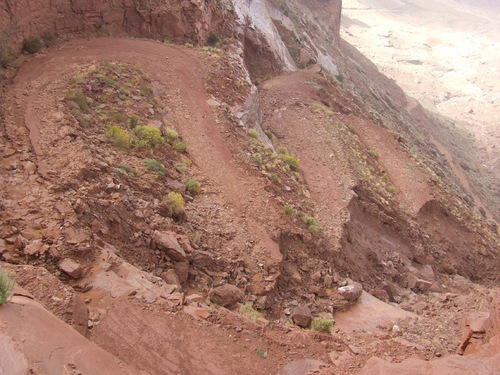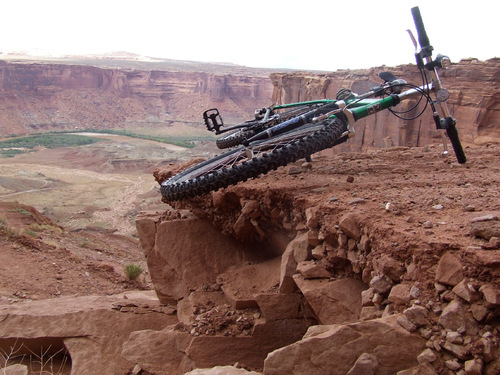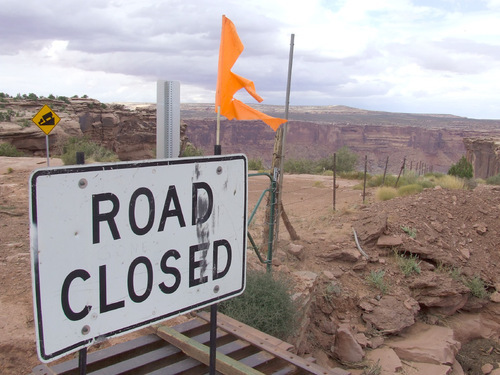This is an archived article that was published on sltrib.com in 2010, and information in the article may be outdated. It is provided only for personal research purposes and may not be reprinted.
Moab • It seemed like just a spotty August thunderstorm to the leaders of a Boy Scout canoe trip — not even enough to force the troop from the Green River — until a search-and-rescue helicopter dropped onto a sandbar and people with walkie-talkies got out and warned them to stop before their designated take-out ramp.
The cumulative effect of seasonal monsoons had, by Aug. 19, obliterated many of the steep, rocky switchback legs of Mineral Bottom Road, the Scouts' destination and a key link in Moab's river running and mountain biking industries. More than a recreational convenience, the road is a jobs conduit that still needs fixing for next year's tourism rush.
If the Scouts had drifted as far as Mineral Bottom, they would have had no choice but to keep going a few days longer to the next take-out, where the Green meets the Colorado. Instead, the Grand County Sheriff's Office assisted them and other floaters up a narrow, white-knuckle Jeep route at Spring Canyon, upstream from Mineral Bottom.
"We had stopped that morning to play a game of Frisbee," Scoutmaster Ron Huntzinger, of Lindon, recalled. "If we hadn't done that, we'd have been past [Mineral Bottom]."
Timing is everything, and some of Moab's tourism companies count themselves lucky to have dodged economic catastrophe. Had the road's washout come earlier in the year, when tourists were booking trips, locals might have been out of work. Instead, guides and shuttles labored extra hours to find alternate but less ideal routes, and people who had committed to their vacations came anyway.
Now the question is: Will they keep coming next year if the road remains a crumbling cascade of boulders and red dirt?
Grand County doesn't want to accept that, and the U.S. Bureau of Land Management says the community cannot afford it. Together they are scrambling to find emergency federal funds to rebuild the road and the economy, mindful of the fact that another snowy winter like last year's would prohibit reconstruction by the usual April tourist flood. They applied to the Federal Highway Administration for emergency aid of $1.8 million to $2.5 million, and Rep. Jim Matheson, D-Utah, sent the agency a letter backing the bid.
Highway officials have said the road, maintained by the county but crossing federal land, qualifies for an emergency funding program to aid federal highways. They haven't yet approved the application, though.
The BLM estimates the road supports 87 jobs and about $1.9 million in annual recreation sales.
Guide services wait and wonder about their prospects for next year. The road, accessing the Green from a high plateau at the northwest edge of Canyonlands National Park, is the most important access point for flat-water float trips.
After the rock slide, Tex's Riverways offered guests the choice of floating the Colorado instead. Some did, even though they would have preferred the quiet of the Green's Labyrinth or Stillwater canyons. The jet-boat shuttles running between Moab and the Colorado's confluence with the Green put off some floaters.
"If you're starting from a blank slate, which we are for next season," Tex's co-owner Darren Vaughan said, "people aren't going to do it."
In that case, Tex's probably will run its van shuttles to Spring Canyon, the road that the Scouts were forced to use this summer.
Vaughan said the company avoided it this season because it's too narrow and steep to serve much commercial traffic, but employees will find a way to use it if Mineral Bottom isn't restored by spring.
"For the early part of next year we're just going to have a fairly unexcited dialogue with [tourists] about Mineral Bottom versus Spring Canyon," Vaughan said. "You just do what you gotta do for as long as you gotta do it."
The Scout troop's ordeal illustrates the test that awaits commercial operators if they are stuck with Spring Canyon Road. First off, Scoutmaster Huntzinger said, the boys found the usual take-out spot there washed away, and they had to lift their canoes up a 15-foot embankment to reach flat ground. Then they haggled with sheriff's deputies, who had kept their support crew from bringing an eight-canoe trailer down the steep road for fear it wouldn't make it out. Eventually, they brought the trailer down and loaded it, and deputies had to direct traffic among them and other river-running groups because the road is too narrow for oncoming vehicles to pass.
"It's precarious," Huntzinger said.
BLM recreation planner Jennifer Jones said rolled, crunched cars left in the canyon are evidence of past difficulties staying on Spring Canyon Road.
"It's fairly challenging on a good day," she said. "If you're from the East, it's really breathtaking to think that there's even a road there in the first place."
Mineral Bottom Road is part of the popular multi-day White Rim mountain biking loop, where guides provide vehicle support for bike campers. Without that link, cycling companies and volunteers have pioneered a trail across a steep talus slope to allow cyclists to carry their bikes past the washed-out switchbacks. It's a challenging task, and support vehicles cannot accompany them.
"It's maybe more adventure than they wanted," Jones said.
Rim Tours co-owner Kirstin Peterson said the inconvenience is costing a lot of staff hours, because the person driving the support vehicle has to circle back and drive an eight- or nine-hour loop to get camp supplies to the cyclists, who hike their bikes past the Mineral Bottom roadblock.
Like the float-trip companies, she fears bikers who know of the problem months in advance just won't book trips.
"We've made the best of the situation this fall," Peterson said, "but it would be great if they could fix the road early enough this spring so that we could be back in action by April."
There is only an outside chance of that. Grand County Administrator Melinda Brimhall said county and BLM officials have settled on early summer as a realistic goal. Engineering and possibly a contractor bid process still must occur before work starts, she said, and that's assuming the funding comes through soon. Then the blasting and grading could take 12 weeks.
"There are some businesses in Grand County that center what they do around that road," she said. "Hopefully, they'll be able to hang in there."







